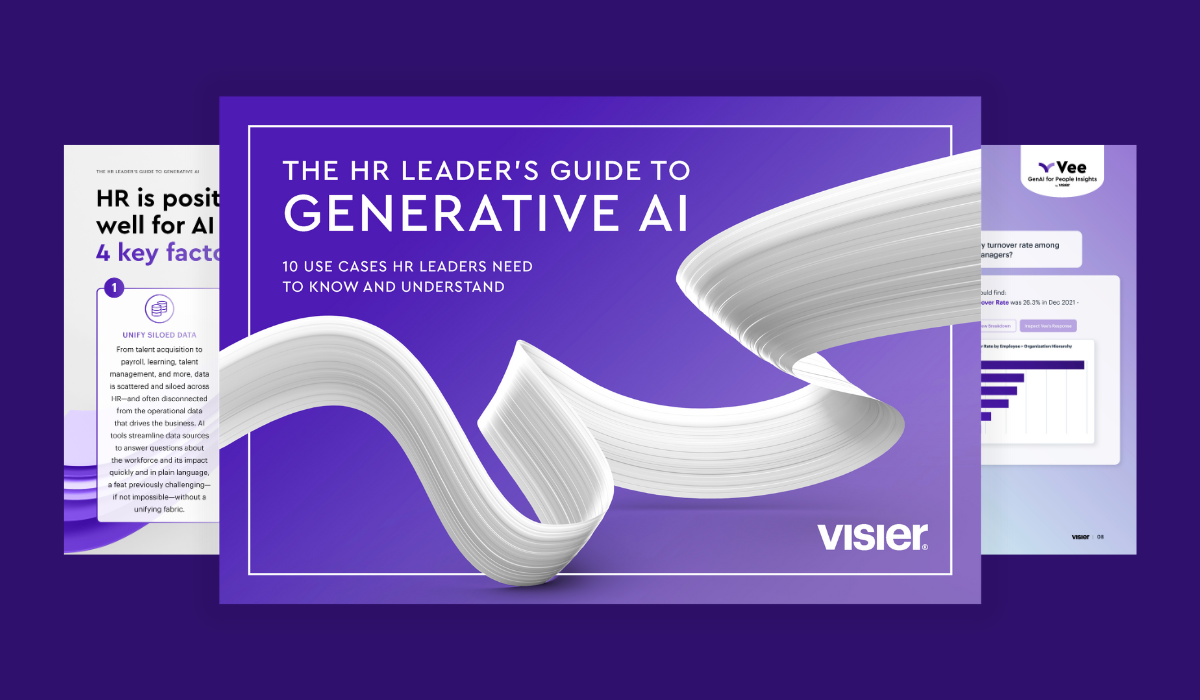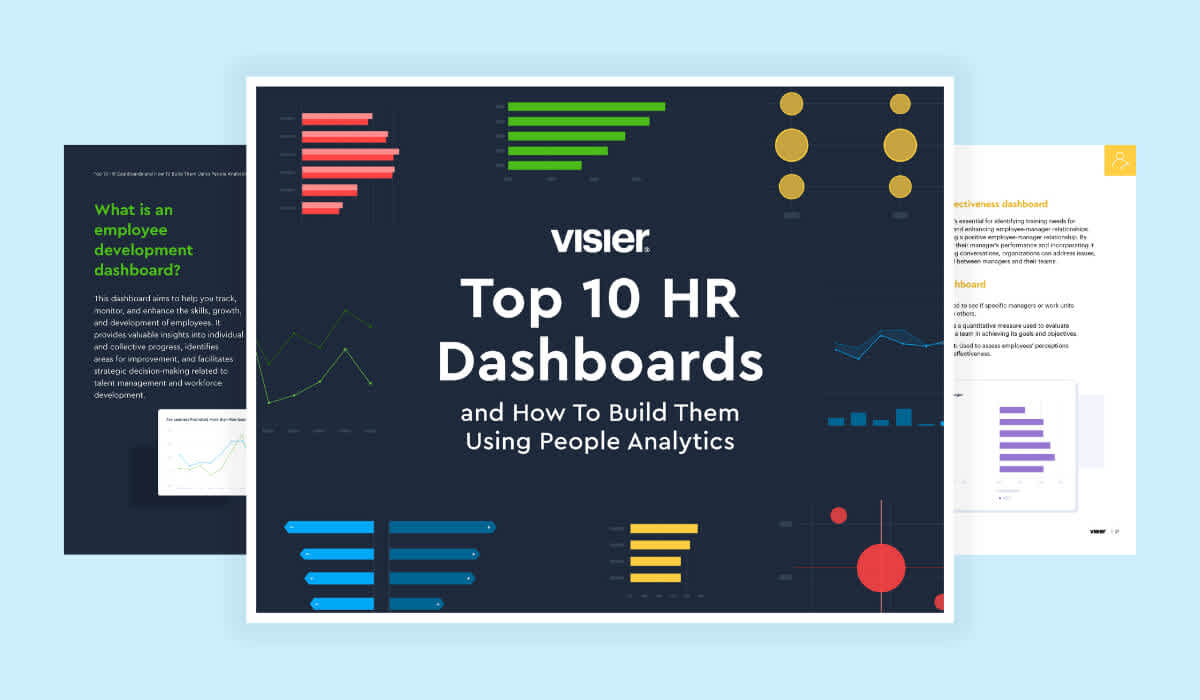10 Questions Vee Can Answer for HRBPs Instantly
Vee, Visier's genAI assistant, answers questions for HRBPs about the workforce in seconds. Take a look at 10 real examples of answers from Vee.

This post is part of a series of questions to ask generative AI for people analytics. Explore other posts in the series to learn which questions AI can answer for workforce planning leaders, compensation and total rewards teams, people analytics leaders, frontline managers, and CHROs.
HR business partners (HRBPs) are pivotal in bridging the gap between HR strategies and business objectives. Understanding the business and its strategy, customers, and personnel challenges is central to an HRBP's role.
HRBPs act as liaisons between HR departments and business units, collaborating with leaders to forge and execute HR strategies that support business goals and impact outcomes. In fact, according to Gartner, organizations that prioritize developing high-performing HRBPs see up to a 22% improvement in employee performance, a 24% increase in retention, and notable boosts in revenue and profit—up to 7% and 9%, respectively.
Many organizations want to enable their HRBPs to adopt a data-driven approach, but people data is complex and lives in multiple systems of record. How can HRBPs get their arms around all of the relevant data to help make informed people decisions? People analytics bring data from multiple systems into one and transform it into actionable insights that HRBPs can use to help business leaders make better decisions. With the emergence of generative AI (GAI), accessing critical insights is even faster.
![[ANIMATED SHORT] HRBP Questions](https://images.ctfassets.net/lbgy40h4xfb7/1o85kzcXWAMAxqTT9fjDn1/807d9b5560040f14b90a06bb25084e77/ask-vee-thumbnail.jpg?w=1200&h=700&fl=progressive&q=50&fm=jpg)
HRBPs can solve issues on the fly using genAI
Data literacy varies among roles and departments—not everyone is a data analyst. That’s where tools like Visier’s generative AI assistant, Vee, come into play. Vee provides plain-language answers to everyday questions from HRBPs, line managers, CHROs, and anyone with the right permissions. This ensures that users, regardless of their level of data literacy, can access pertinent workforce insights in seconds.
By increasing access to self-serve analytics, genAI is poised to transform the HRBP’s role. Let’s take a look at this in action. Consider a situation where an HRBP is approached by the head of the company’s sales organization who has noticed a concerning pattern: Senior representatives seem to be leaving after only about two years of service. It’s a trend that could significantly impact the company’s revenue and profitability. But is it a trend that’s “real”?
The HRBP turns to Vee, asking for help to analyze attrition data for the sales division and indicate whether it’s an anomaly or part of a trend. Vee can analyze exit interview data, employee satisfaction surveys, and other metrics to uncover potential drivers of what appears to be a trend. In addition, by comparing attrition rates in the sales division with company and industry data sources, the scope of the issue can be evaluated.
By enabling the HRBP to access and analyze data in real time, Vee empowers them to work with speed and precision in collaboration with the business leaders to assess and intervene, as necessary.
10 questions HRBPs can ask generative AI
On any given day, HRBPs are asked tons of questions from stakeholders across the organization. They need to be able to provide fast, accurate answers. With genAI, HRBPs can ask questions and make informed decisions on the spot. Here are ten examples of the types of questions Vee can answer for HRBPs in seconds.
1. What is the attrition rate among customer support managers?

Customer service is a critical role in any organization, but when customer service managers exit too often, service can be negatively impacted. Vee can help you easily track and trend attrition rates among your customer service managers, pointing to potential opportunities for training or other interventions to improve longevity.
2. Compare the rate of training course completion with retention on the sales team.
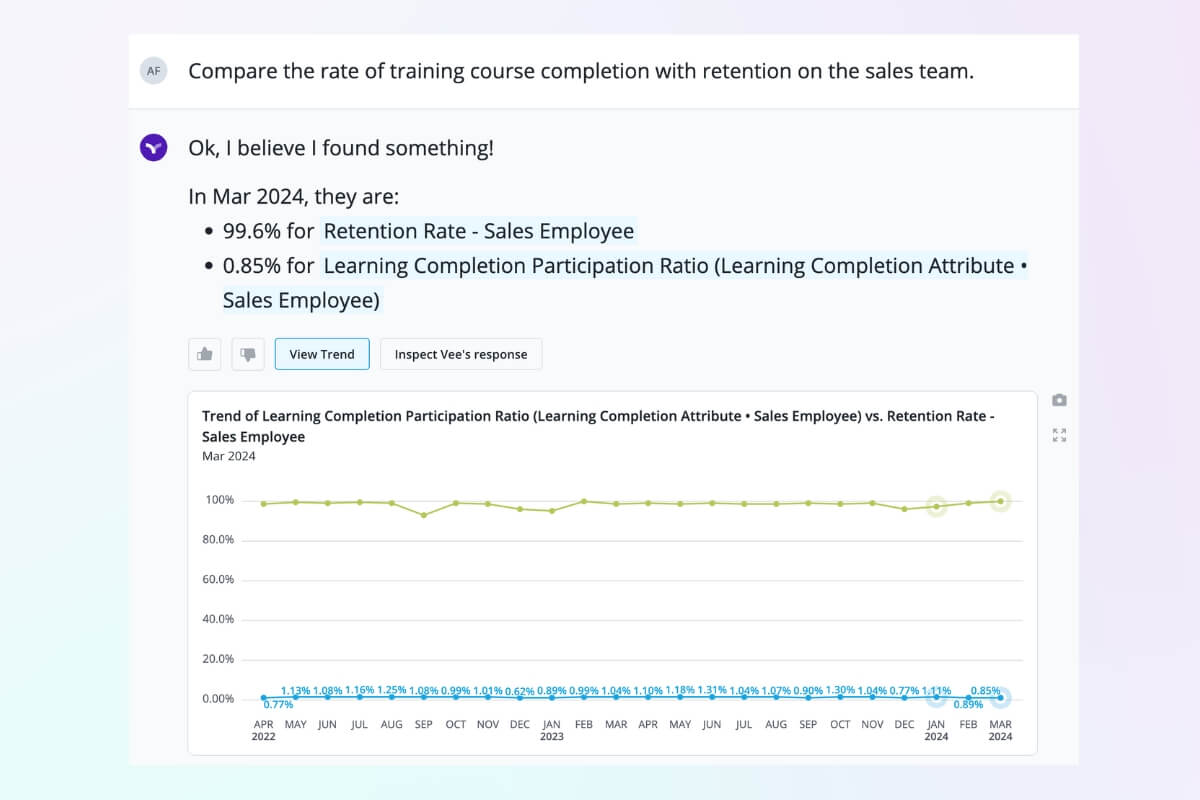
How does training course completion impact retention among your sales teams? Vee can quickly give you the answers, identifying areas where more learning and development support may be needed. This data can inform decisions on training investments and highlight the need for additional support for new hires.
3. What is the turnover rate for the sales organization this quarter?

Understanding how quickly and frequently turnover occurs can provide a snapshot of your company’s overall health and employee satisfaction. Drilling down into this data can help spot disparities between departments or roles within the organization, highlighting opportunities for course correction and unearthing best practices.
4. Which managers in the sales organization have the highest turnover?

Some managers are more effective than others at keeping staff on board—but which ones? Identifying managers with high turnover rates can signal leadership or team issues that need to be addressed. HBRPs can use this data to provide targeted coaching or training to improve management practices.
5. Which groups have the highest turnover?

High turnover in specific groups may indicate systemic problems or dissatisfaction. For instance, are your remote workers exhibiting higher turnover than staff that work on-site? Are hybrid workers staying on board longer than fully on-site staff? HBRPs can use this information to investigate and address the root causes, such as work conditions, compensation, or career development opportunities.
6. How happy are employees in the sales organization?

Understanding employee happiness in the sales organization is crucial, as it directly affects the teams’ motivation, productivity, and retention. By tracking employee satisfaction, HRBPs can pinpoint issues and make recommendations to prevent potential burnout and turnover. With Vee, you can conversationally ask follow-up questions, like the one below.
7. How does employee NPS in the sales organization compare to other departments for this quarter?
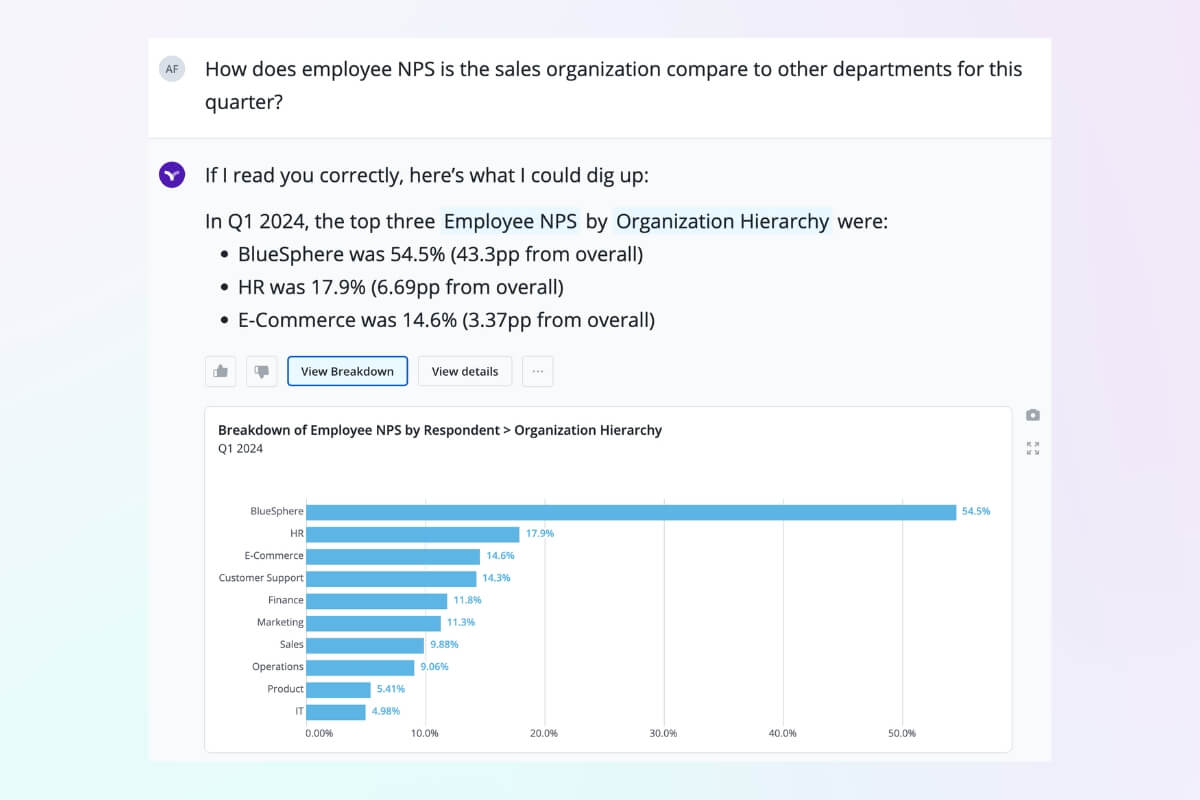
Comparing the Employee Net Promoter Score (NPS) in the sales organization to other departments helps HRBPs and sales leaders identify specific areas where the sales team may be excelling or facing challenges in terms of employee engagement and morale, which can significantly impact their performance and effectiveness in sales roles. By analyzing these trends, HRBPs can tailor interventions, training, and policies that address the unique needs of the sales department.
8. How many managers do we have in the sales organization?

Knowing the number of managers is fundamental for workforce planning and understanding organizational structure. Armed with this data, HRBPs can ensure proper leadership coverage and identify potential gaps or surpluses in management roles.
9. What is their span of control?
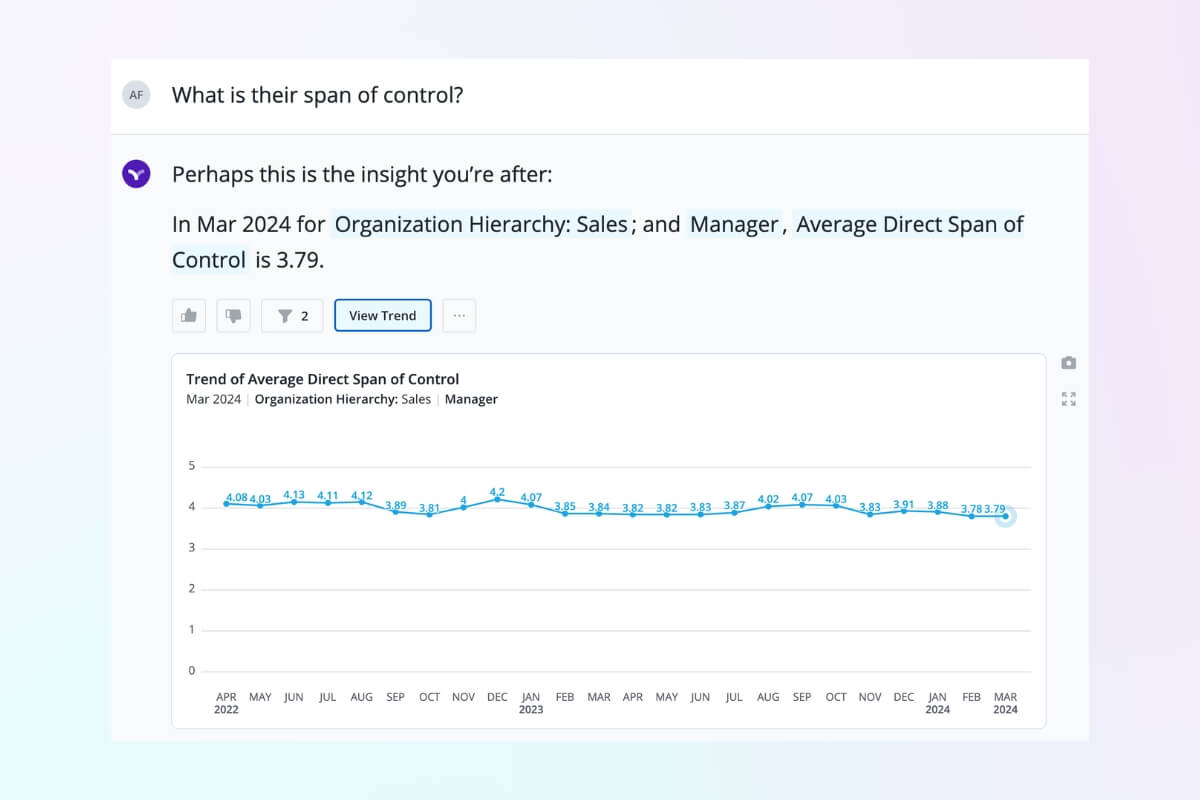
Understanding the span of control among managers can help HRBPs evaluate whether managers have too many or too few direct reports, pointing to opportunities for staffing shifts or new hires. This information can inform organizational design and manager workload distribution.
10. How effective are managers in the sales organization this quarter compared to last quarter?

Effective sales managers are pivotal, as their leadership directly influences employee satisfaction, retention rates, and the overall success of sales initiatives. Understanding how effective managers are over time, and how effective they are compared to other departments, can lead to actions that ensure sales teams are led efficiently.
Empower HRBPs with instant people analytics from Vee
Having instant access to data and answers allows HRBPs to quickly identify and address issues, capitalize on opportunities for improvement, and strategically align HR initiatives with business objectives. The ability to drive results from this data can lead to better workforce management, higher employee satisfaction, and ultimately, a more successful organization.
Vee gives you at-your-fingertips access to the data you need to improve retention, productivity, and engagement—and the ability to drill down to identify impacts based on demographics, location, role, and more.

Generative AI for people analytics and HR
Vee, Visier’s generative AI digital assistant delivers fast, intuitive, accessible workforce insights to people leaders. Learn the latest product updates here.
To keep up with the future of work, HR leaders need a strategy that's agile, adaptable, and rooted in data. GenAI can help close the gap between people data and business data. Ian Cook and Robert Sullivan share how.
Vee answers people analytics leader's questions about the workforce in seconds. Here are 10 real examples of answers from Vee.
Generative AI innovations like digital assistants are changing the way we work, and pose significant security challenges. Are they secure enough to use with people data?
As the use of AI continues to evolve, it's critical to comply with AI regulations like the EU AI Act and the U.S. AI Bill of Rights. But where do you start?
